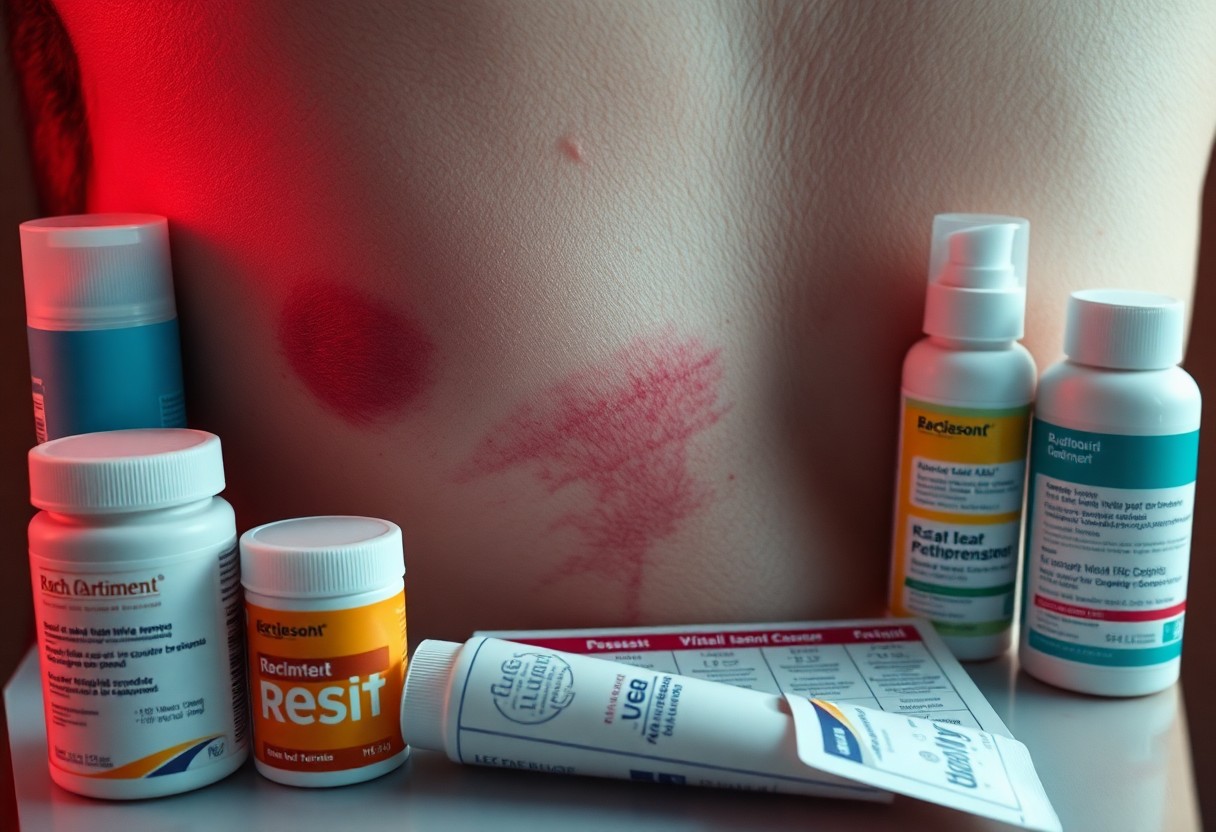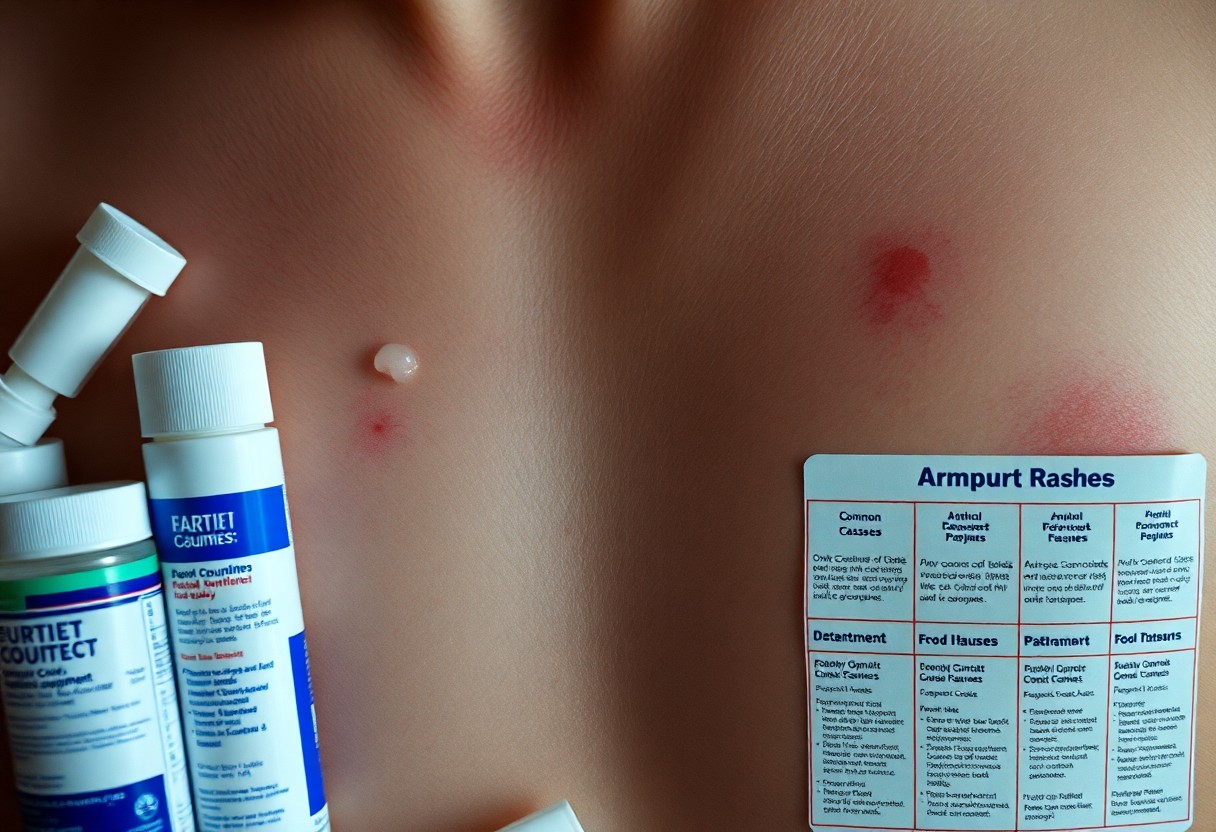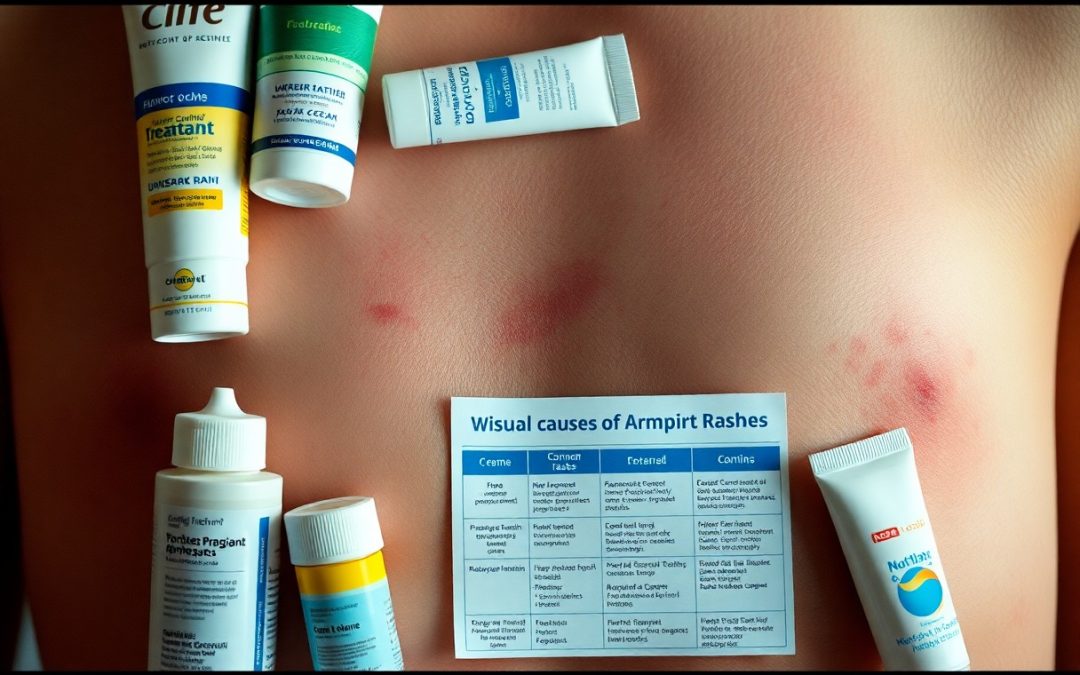Over time, you may experience discomfort from an armpit rash, which can stem from various causes such as friction, allergies, or infections. Understanding the underlying factors contributing to your irritation is crucial for effective treatment. In this guide, we’ll explore the causes of armpit rashes, effective treatment options, and provide a visual reference to help you identify and manage your symptoms better. Your skin deserves the best care, so let’s uncover the best strategies for relief and prevention.
Understanding Armpit Rash
Your armpit rash may be a temporary concern or a sign of an underlying issue. Often uncomfortable and sometimes painful, armpit rashes can develop for various reasons, including friction, infections, and skin conditions. Knowing how to identify and address these rashes can help alleviate discomfort and prevent recurrence.
Definition and Symptoms
Below are some common symptoms associated with armpit rashes, which may manifest as redness, irritation, raised bumps, or even oozing fluids. These rashes can be caused by a variety of factors, including moisture, friction, and allergic reactions, and may present in a way that is uncomfortable for you.
Common Locations
With armpit rashes, they typically develop in the underarm area or surrounding skin. The warm, moist environment of the armpit provides an ideal setting for irritation and infections.
Indeed, the armpits are prone to rashes due to their frequent exposure to sweat and friction from clothing or movement. This area is often closed off and dark, creating a breeding ground for irritants and bacteria. Conditions like friction dermatitis and fungal infections thrive in this environment, leading to inflammation and discomfort. Being aware of the sensitive nature of your armpit skin can help you take preventative measures against rashes.
Causes of Armpit Rash
Assuming you’re experiencing discomfort, understanding the causes of armpit rash is important for effective treatment. Various factors can contribute to this condition, ranging from friction and irritation to allergic reactions and fungal infections. Identifying the underlying cause helps you select the best course of action to relieve your symptoms and maintain healthy skin.
Friction and Irritation
For many, friction dermatitis, often referred to as chafing, is a major contributor to armpit rashes. This occurs when your skin rubs against itself or clothing, exacerbated by warmth and sweating. Activities such as exercising and wearing tight clothes can increase irritation, leading to red, irritated patches on your underarm skin.
Allergic Reactions and Infections
At times, allergic reactions or infections can result in armpit rashes as well. Some components in deodorants, soaps, or laundry detergents may trigger sensitivities in your skin, leading to irritation and discomfort. Additionally, fungal infections such as Candida can thrive in the warm, moist environment of your armpits, causing redness and inflammation.
Even if the rash appears mild, it’s important not to overlook it. Allergic reactions usually present as red, irritated patches and might be accompanied by itching, while infections could produce more severe symptoms like swelling, pus, or an unpleasant odor. Identifying whether the rash is a result of an allergic reaction or a fungal infection enables you to pursue appropriate treatment and prevents potential complications.

Visual Guide to Armpit Rashes
Any armpit rash can vary in appearance and severity, making a visual guide helpful for understanding the different conditions that can affect your underarm area. By recognizing the features and specific characteristics of each type, you can better assess your symptoms and determine when to seek professional advice.
Photographic Examples
Rashes in the armpit area often present themselves in various forms, from red and irritated skin to raised bumps or even painful lumps. Images of common conditions like friction dermatitis, contact dermatitis, and fungal infections can provide clarity, helping you to identify your symptoms more effectively. This visual representation makes it easier to relate your own experiences to known rashes and their causes.
Identifying Characteristics
One key to managing an armpit rash is recognizing its identifying characteristics. Different types of rashes will have unique signs, such as color, texture, and location, which can guide your understanding of the underlying cause. For instance, friction dermatitis often leads to red, irritated areas due to skin rubbing against itself or clothing, while a fungal infection may appear bright red with raised bumps and a distinct odor. Understanding these differences can significantly aid in determining effective treatment options and when it’s necessary to consult a healthcare provider.
It is important to closely observe the identifying characteristics of your rash. Each type has its own distinct features; for instance, contact dermatitis may present as flat, itchy patches, while hidradenitis suppurativa typically manifests as painful nodules in the armpits. By paying attention to these details, including the rash’s progression and any associated symptoms like discomfort or odor, you’ll be equipped to make informed decisions about your care and potential treatment methods. If the rash persists or worsens, seeking a dermatologist’s expertise is advisable to address the condition appropriately.

Effective Treatments
Despite the discomfort that an armpit rash can cause, several treatments can help you find relief and restore your skin’s health. Home remedies, such as applying skin-safe ointments and eliminating irritating products, can provide immediate relief. However, if your symptoms persist or worsen, seeking professional medical options may be necessary to address underlying conditions effectively.
Home Remedies
For many armpit rashes, home remedies can be quite effective. You can apply a soothing skin-healing ointment, such as diaper rash cream or petroleum jelly, to your underarms. Additionally, avoid using products that contain fragrances or preservatives, which are common culprits for irritation. Keeping the area dry and clean is also imperative in promoting healing.
Professional Medical Options
On the other hand, if home remedies do not alleviate the rash, consulting a healthcare provider is advisable. Medical professionals can identify any underlying issues and may prescribe topical or oral antibiotics, antifungal, or anti-inflammatory medications to treat the discomfort. A dermatologist, in particular, specializes in skin conditions and can offer detailed evaluations and treatments tailored to your specific rash.
And should you require medical intervention, it’s important to be aware that complications can arise from untreated rashes, so prompt action is pivotal. Regular check-ins with a healthcare provider ensure that your skin remains healthy and any conditions are managed effectively. It’s also wise to keep track of any changes you notice in your armpits, as this information can aid in diagnosis and treatment planning.
Complications and When to Seek Help
Keep an eye on your armpit rash, as complications can arise from underlying conditions. If your rash worsens, spreads, or becomes painful, or if you notice signs of infection like increased redness, swelling, or pus, it’s important to seek medical attention. Additionally, if you experience fever or feel generally unwell, don’t hesitate to consult a healthcare provider for proper evaluation and treatment.
Signs of Severe Conditions
Above all, you should be aware of symptoms that may indicate a more serious problem. If you observe persistent lumps, intense itching, or an unusual odor from your rash, these can be signs of conditions like hidradenitis suppurativa or a severe fungal infection. Additionally, rashes accompanied by fever or feeling unwell warrant immediate medical attention.
Importance of Medical Evaluation
When your at-home treatments aren’t effective, or if your rash is accompanied by alarming symptoms, seeking a medical evaluation is the best course of action. Early intervention can prevent more serious complications and ensure you receive the appropriate care based on a proper diagnosis.
But understanding your armpit rash and its potential complications can empower you to take action. Consulting a healthcare provider like a dermatologist can result in tailored treatments, such as topical or oral medications for infections, allergies, or underlying skin conditions. This proactive approach is key to maintaining your skin health and alleviating discomfort.
Prevention Strategies
All effective prevention strategies focus on maintaining optimal hygiene and choosing suitable products for your underarm area. Keeping your armpits clean and dry is imperative in reducing the risk of rashes. Incorporating routine care and being mindful of the products you use can help you avoid common irritants and skin issues.
Daily Care and Hygiene
Daily hygiene is vital for preventing armpit rashes. Wash your underarms with antibacterial soap to eliminate bacteria and moisture, which can lead to irritation. Gently exfoliating your armpits with a body brush one to three times a week helps remove sweat, oil, and product buildup, allowing your skin to breathe and stay healthy.
Choosing the Right Products
Against using products containing fragrances, preservatives, and propylene glycol is advisable, as these are common irritants that can lead to rashes. Opt for gentle, hypoallergenic deodorants and body washes designed for sensitive skin to minimize the risk of irritation.
Indeed, selecting the right products is imperative for maintaining healthy skin in your underarms. Look for items that are fragrance-free and formulated without harsh chemicals. Ingredients like zinc oxide in diaper rash ointments can soothe irritated skin, while gentle, moisturizing cleansers can help prevent dryness and irritation. Always patch-test new products to see how your skin reacts before applying them broadly to your underarm area.
Understanding Armpit Rash: Causes, Effective Treatments, and Visual Guide for Relief
With this in mind, understanding the various causes of armpit rash can help you identify the appropriate treatment options for your situation. Whether dealing with friction, contact dermatitis, or fungal infections, you can take actionable steps to protect your skin and prevent discomfort. By examining visual guides and practicing effective home remedies, you can alleviate symptoms and enhance the health of your underarm area with confidence.


